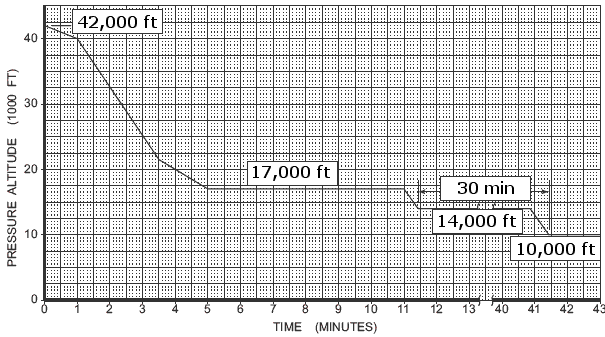Oxygen Requirements
The following notes are from the Flight Planning and Performance Manual
Passenger Oxygen System - Chemical
This airplane is equipped with a 12 minute chemical passenger oxygen system. The altitude envelopes provided show the maximum altitude that the airplane may be flown during a cabin depressurisation event and still support the physiological requirements of the passengers using he oxygen system installed. The envelopes are intended to assist in terrain clearance planning.
The maximum altitude envelopes assume an immediate descent is made to 10000 ft or the lowest safe altitude whichever is higher as stipulated in the Emergency Descent procedure of the Quick Reference Handbook. Should the presence of terrain necessitate a level-off at an altitude higher than 10000 ft, the required terrain clearance descent profile should at no time exceed the maximum altitude capability of the passenger oxygen system shown by the envelope. Once terrain is cleared, the descent to 10000 ft should be completed.
JAROPS rules allow the first 30 minutes the airplane is flown at altitudes at or below 14000 ft but above 10000 ft to be without additional supplemental passenger oxygen.

The passenger oxygen system will provide sufficient supplemental breathing oxygen
for altitudes at or below this envelope.
Flight Crew Oxygen Requirements
Regulations require that sufficient oxygen be provided to the flight crew to account for the greater of supplemental breathing oxygen in the event of a cabin depressurisation or protective breathing in the event of smoke or harmful fumes in the flight deck.
This airplane model is equipped with a 12 minute chemical passenger oxygen system which limits the extent to which the airplane can be operated at altitudes above 10000 ft following depressurisation. As a result the flight crew supplemental oxygen quantity requirement is determined using the fixed maximum cabin altitude envelope allowed by the passenger oxygen system. Consideration must also be give to protective breathing oxygen, which is the quantity of oxygen necessary for 15 minutes of pressurised 100% oxygen flow (Emergency setting) for each flight crew member in a fully pressurised cabin (8000 ft cabin pressure altitude). The greater quantity of either the supplemental or protective breathing requirements is used to determine the minimum dispatch cylinder pressures provided. An additional 10% of oxygen quantity is supplied by the values provided in the tables to account for normal system leakage and for use by one active duty pilot at flight altitudes above 25000 feet should the other active duty pilot leave the flight deck
To determine the minimum dispatch oxygen cylinder pressure enter the flight crew oxygen table with the number of crew plus observers using oxygen and read the minimum cylinder pressure required for the appropriate cylinder temperature. An additional quantity of oxygen is required when flight altitudes above 41000 feet are planned. Above flight altitudes of 41000 feet one active duty pilot must don the oxygen mask and breath diluted oxygen for the duration of the flight above 41000 feet. The additional quantity of oxygen required is 2.05 litres/pilot/minute. This is equivalent to 1.8 psi/pilot/minute.
| Required Pressure | |||||
|---|---|---|---|---|---|
| Bottle Temperature | Number of Crew using Oxygen | ||||
| °C | °F | 2 | 3 | 4 | 5 |
| 50 | 122 | 735 | 1055 | 1360 | 1680 |
| 45 | 113 | 725 | 1040 | 1340 | 1655 |
| 40 | 104 | 715 | 1020 | 1320 | 1630 |
| 35 | 95 | 700 | 1005 | 1300 | 1600 |
| 30 | 86 | 690 | 990 | 1280 | 1580 |
| 25 | 77 | 680 | 975 | 1255 | 1550 |
| 20 | 68 | 670 | 960 | 1240 | 1530 |
| 15 | 59 | 655 | 940 | 1215 | 1500 |
| 10 | 50 | 645 | 925 | 1195 | 1475 |
| 5 | 41 | 635 | 910 | 1175 | 1445 |
| 0 | 32 | 620 | 890 | 1150 | 1420 |
| -5 | 23 | 610 | 875 | 1130 | 1395 |
| -10 | 14 | 600 | 860 | 1110 | 1370 |
Boeing Flight Planning and Performance Manual - Chapter 2